Canning tomatillos is actually quite easy and fun to do. Plus it’s a convenient way to keep them on hand whenever you need them in your recipes.
Use the fruits fresh from your garden, or stock up from the farmer’s market or grocery store. They’re great for making salsa, adding to your recipes, or cooking sauces like salsa verde.
In this step by step guide, I’m going to show you exactly how to can your own tomatillos, including packing, process, and storage tips too.
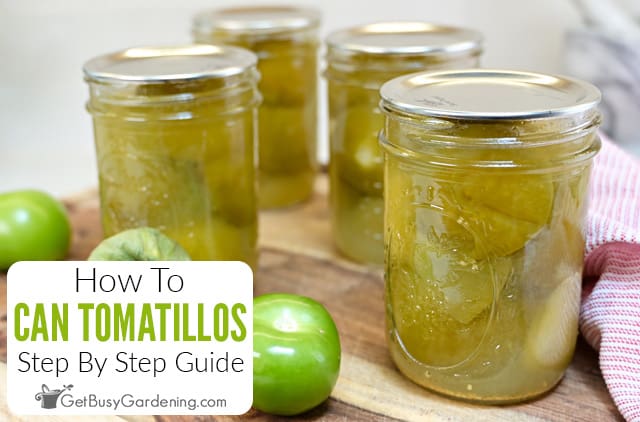
Can Tomatillos Be Canned?
I get asked by gardeners all the time if tomatillos can be canned, and the answer is yes.
It’s surprisingly easy to do, and doesn’t take much time. Plus you can use either a boiling water bath or a pressure canner, so you don’t need to buy any special equipment.
Preparing Tomatillos For Canning
To prepare your tomatillos for canning you will need to first remove the papery outer husks and stems. Then rinse them to remove any dirt or debris.
It’s best to leave them whole, so don’t cut them up or remove the seeds. However, because their skin is tough, you should puncture them with a knife to prevent them from bursting during processing.
Piercing the skin is an optional step, but will ensure your canned tomatillos stay whole and look their best inside the jars.
Related Post: How To Grow Tomatillos At Home
Methods For Canning Tomatillos
The best method to use for canning tomatillos is to hot pack them. This will soften them up and create the ideal texture. I do not recommend raw packing them, because they will end up being too hard.
Hot Packing
To hot pack all you need to do is blanch the tomatillos in boiling water for about 5-6 minutes before canning them.
You’ll know they are ready when they lose their bright green color. Then you can place them in the jars and pour hot water over the top.
Instead of boiling them, you could roast them in the oven first, which will give them a richer flavor than boiling will.
Related Post: How To Freeze Tomatillos (With Or Without Blanching)
Processing Canned Tomatillos
Once you’ve hot packed your tomatillos into the jars it’s time to process them. You can do it using either a pressure canner or water bath. Below are the pros and cons for each.
Whichever processing method you choose, it’s essential to add 1 tablespoon of lemon juice to each pint jar, or 2 tablespoons per quart, to ensure the acidity is high enough.
Water Bath Canning Tomatillos
The easiest way to process your jars of tomatillos is using a water bath canner. Since you’ll be adding the lemon juice to increase the acidity, this method is safe.
Once the canner is full and boiling, process the jars for 40 minutes (adjust the time for altitude if necessary).
The only downside to this method is that it takes longer. If you already have a pressure canner, then you can use that to speed things up.
Pressure Canning Tomatillos
While you can use a pressure canner, it’s important to note that it’s still essential to acidify your jars with lemon juice.
Process the jars for 15 minutes at 5 pounds of pressure, adjusting for altitude if you need to. The only benefit for using this method is that it’s faster.
Related Post: When & How To Harvest Tomatillos
Tools & Equipment Needed
Below is a list of items you’ll need. Gather everything before you start to make the process easier. You can see my full list of tools and supplies here.
- Pressure canner
- OR Water bath canner
- Wide mouth pint canning jars
- New wide mouth jar lids
- Small cooking pot
- Large cooking pot
- Canning funnel
- Large ladle
- Slotted spoon
- Measuring spoons
- Bubble remover tool
- Jar lifting tool
- Dissolvable labels
- OR Permanent marker

How To Store Canned Tomatillos
Before storing your canned tomatillos, make sure each lid has sealed on the jars. You’ll know they have a proper seal when you push on the center of the lid and it does not move.
If you find that a lid didn’t seal, then you can put that jar into the refrigerator and use it up in 3-4 days.
Otherwise, store your jars in a dark, cool place. A pantry, cupboard, or basement shelf are great spots to keep them.
Be sure to write the date and name on each using dissolvable labels or a permanent marker so you know when they’ll expire.
How Long Do Canned Tomatillos Last?
Home canned tomatillos last up to one year on the shelf when stored correctly.
Once you open them, make sure to store the leftovers in your refrigerator and eat them in 3-4 days.
Related Post: How To Grow Tomatillos From Seed & When To Plant
FAQs
Here I’ve answered some of your most common questions about canning tomatillos.
Do tomatillos need to be pressure canned?
No, tomatillos do not need to be pressure canned, they can be water bath canned instead. But either way, you must add lemon juice to your jars to increase the acidity for safety.
Can tomatillos be canned in a water bath?
Yes, tomatillos can be canned in a water bath, and it’s simple. Just add lemon juice, then place your jars in the boiling water and process them for 40 minutes (adjusting for altitude).
What’s the best way to can tomatillos?
The best way to can tomatillos is by hot packing them into the jars with lemon juice, and then processing them in either a boiling water bath or a pressure canner.
Do you have to cook tomatillos before canning?
Yes, you should definitely cook tomatillos before canning them because they are too hard when they’re raw. You can either boil or roast them first.
Can I can raw tomatillos?
No, I do not recommend that you can raw tomatillos. This is because of how hard they are when raw. Par-boiling or roasting them first will soften them up and create the ideal texture.
What do canned tomatillos taste like?
Canned tomatillos taste similar to cooked, but they’re not as sweet. They’re great to use in any of your recipes.
Can I can whole tomatillos?
Yes you can can whole tomatillos, in fact I recommend it. Cutting them up first would result in a mushier texture. Just be sure to puncture the skins first so the fruits don’t explode during processing.
If you’d like to learn how to make the most of your space and get as much homegrown food as possible, then my Vertical Vegetables book is perfect! It will teach you all you need to know, has tons of gorgeous photos, and includes 23 DIY projects you can build for your own garden. Order your copy today!
Learn more about my Vertical Vegetables book here.
More Food Canning Posts
Share your tips for canning tomatillos in the comments section below.
Recipe & Instructions
How To Can Tomatillos
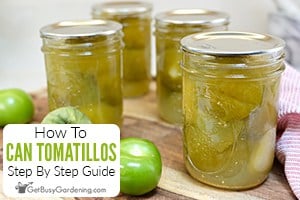
Canning tomatillos is an easy way to keep them all year round. They are perfect to add to any salsa recipe, for making stews or sauces, or your favorite salsa verde.
Ingredients
- 4 pounds of tomatillos
- 4 cups of water
- 1 Tablespoon of lemon juice per pint
Instructions
- Prepare the water - Fill your water bath canner, place it on the stove, and turn the burner on high. Then fill 2 cooking pots, one with enough water to blanch the tomatillos, and the other with 4 cups of water for the canning liquid, and bring both of those to a boil as well.
- Prep the tomatillos - Remove the husks and stems, then rinse the tomatillos to remove dirt and debris. Puncture the skin of each one to prevent bursting (optional).

- Hot pack - Blanch the whole tomatillos in the larger pot of boiling water for 5-6 minutes. Then use a slotted spoon to remove them and loosely hot pack them into the canning jars. Discard the blanching water.

- Add boiling water and lemon juice - Pour 1 tablespoon of lemon juice into each jar, then use a large ladle and canning funnel to fill them with the fresh boiling water from the second pot, leaving a 1” headspace.

- Remove air bubbles - Slide your bubble removing tool down the inside of the jars to remove any large air bubbles. Then place a new lid on top of each jar and fasten a band finger tight.

- Process the jars - Use your lifting tool to carefully put the jars into the boiling water bath canner. Then place the lid on top of the canner and process the jars for 40 minutes.

- Remove the jars - Once the processing time is up, turn off the burner and remove the lid from the canner. Allow it to cool for 20 minutes, then remove the jars and place them on a towel to cool to room temperature on the counter.

- Label and store - Label your jars by writing the date on the lid with a permanent marker or using dissolvable labels, then remove the bands and store the jars in a cool, dry dark place, such as a pantry.

Notes
- Do not skip adding the lemon juice to each jar, even if you’re using a pressure canner. The ratio is 1 tablespoon per pint and 2 tablespoons per quart.
- It's important to keep the jars hot at all times. So plan ahead and boil the processing water before filling the jars, then place them in there as soon as they are packed.
- Also, be sure to work fairly quickly to pack your jars so they do not cool down before processing them.
- Don't be alarmed if you hear the random pinging sounds as the jars cool, it just means the lids are sealing.
- If you live at an altitude higher than 1,000 feet above sea level, then you'll need to adjust your pressure pounds and processing time. Please see this chart for the proper conversions.
Nutrition Information:
Yield:
8Serving Size:
1 cupAmount Per Serving: Calories: 73Total Fat: 2gSaturated Fat: 0gTrans Fat: 0gUnsaturated Fat: 1gCholesterol: 0mgSodium: 7mgCarbohydrates: 13gFiber: 4gSugar: 9gProtein: 2g
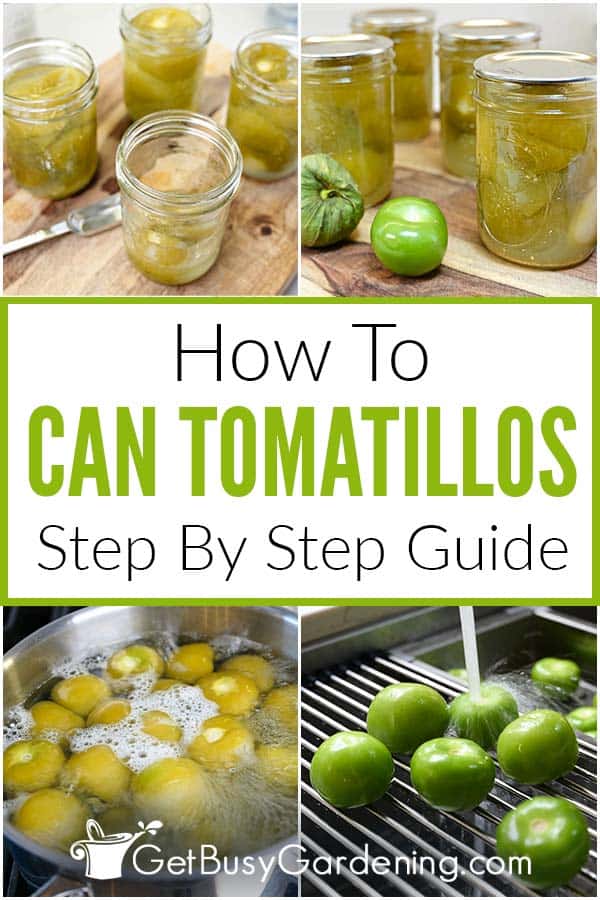
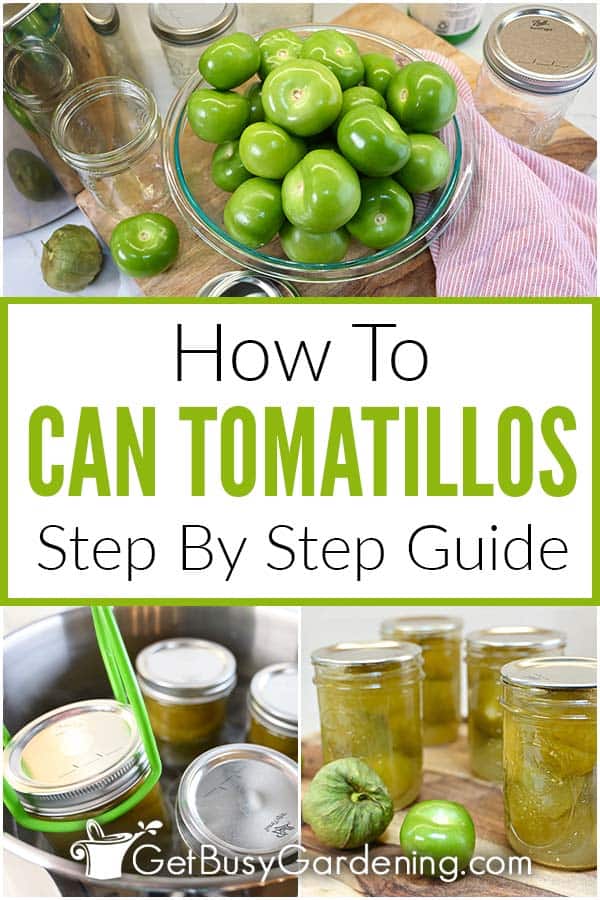
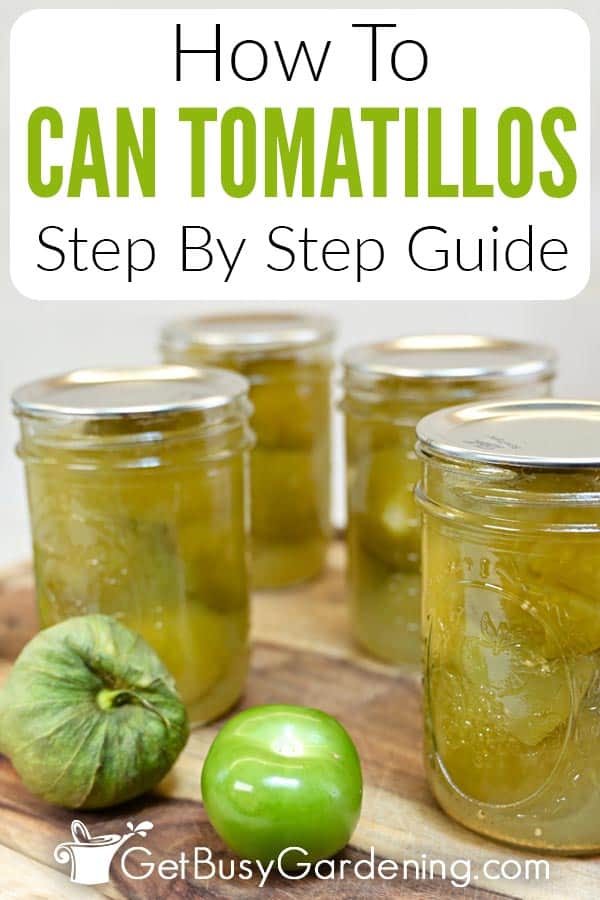

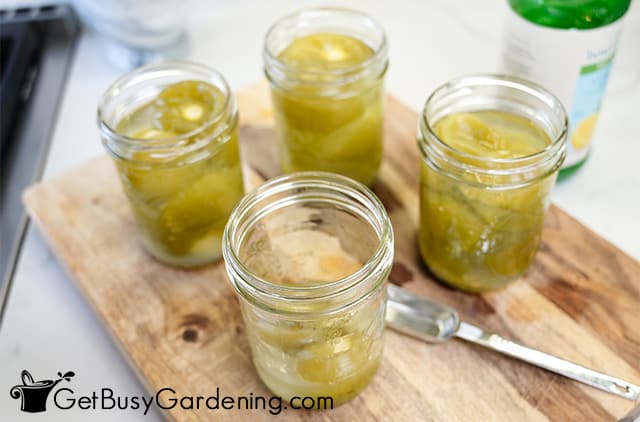
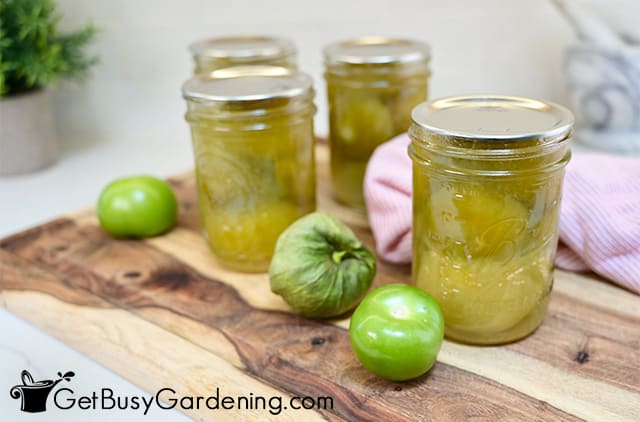

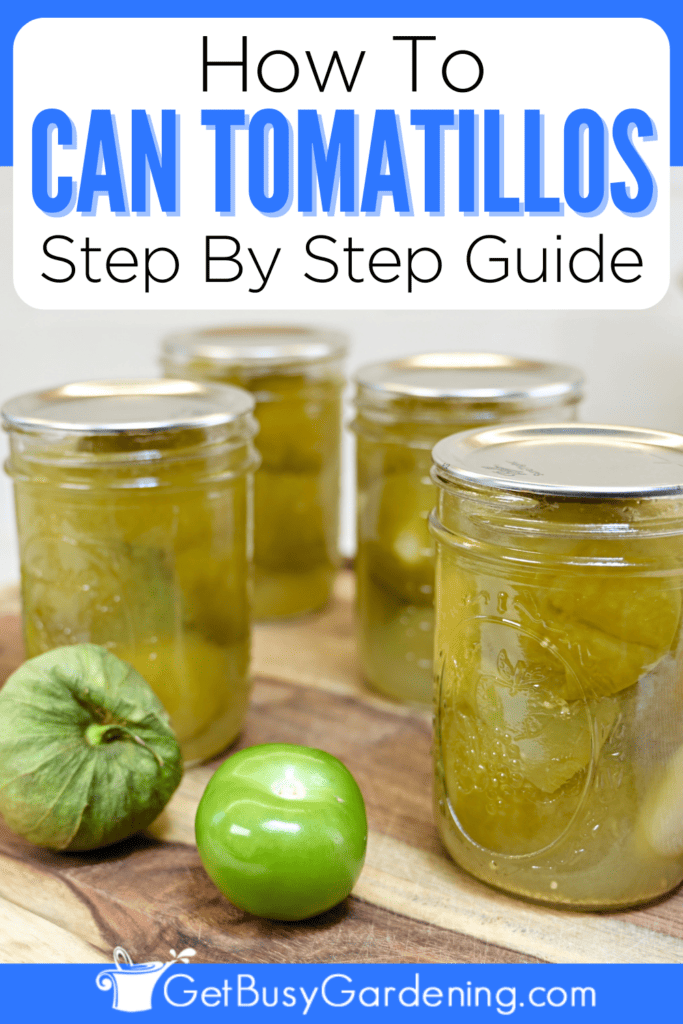

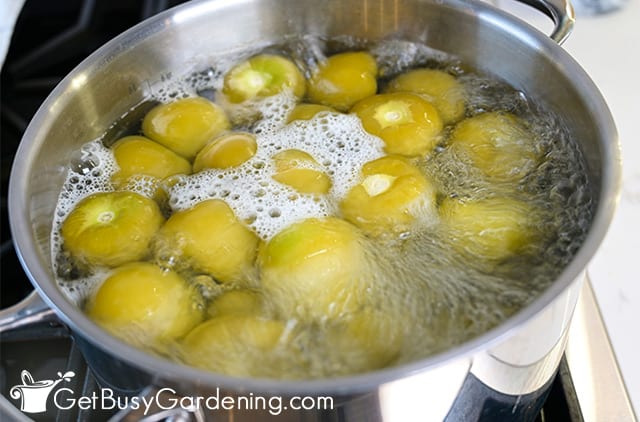
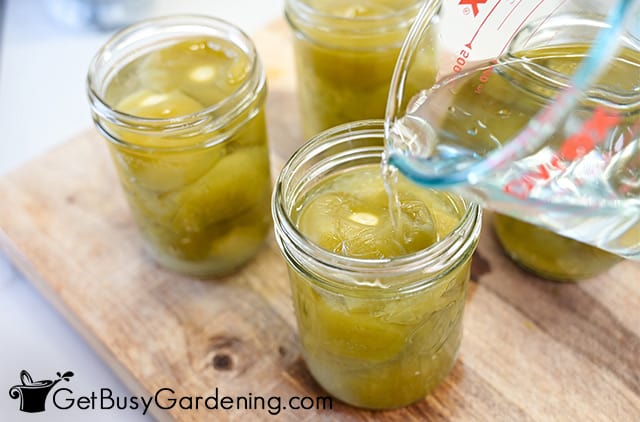
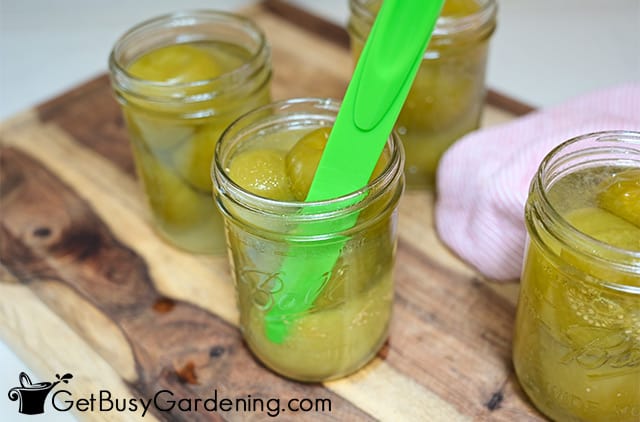
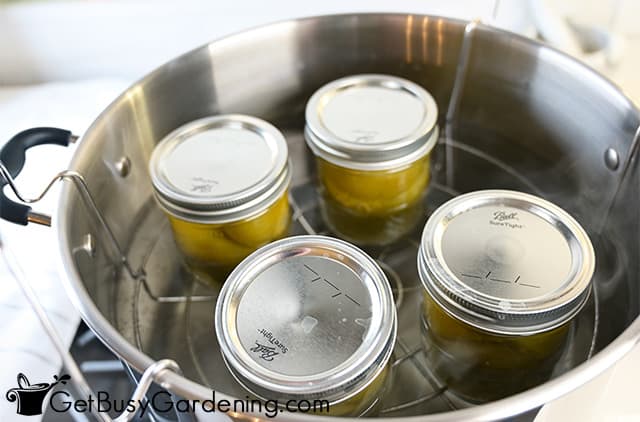
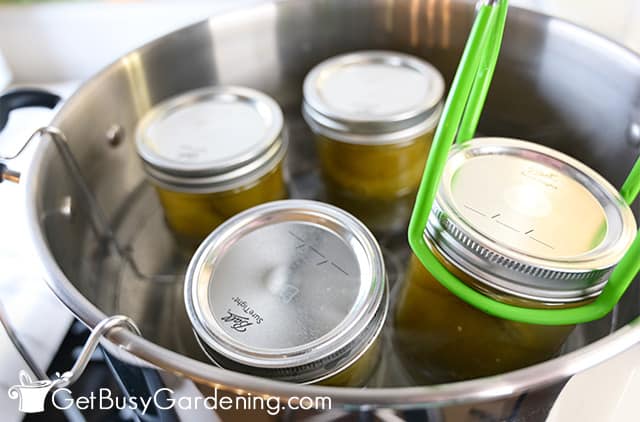


Leave a Reply